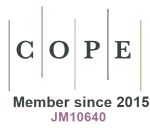Impact of clinico-biochemical variations on the etiopathogenesis of cataract: a case-control study
DOI:
https://doi.org/10.33393/jcb.2023.2479Keywords:
Blood pressure , Blood sugar, Calcium, Cataract, Intraocular pressure, Potassium, SodiumAbstract
Purpose: Cataract is a major cause of blindness worldwide with a greater prevalence in developing countries like India. Owing to speculations about the relationship of various biochemical markers and cataract formation this case-control study was designed with the aim to know the impact of serum blood sugar, serum electrolytes and serum calcium on the etiopathogenesis of cataract in Kashmiri population.
Methods: A total of 300 cases diagnosed with cataract and 360 healthy controls were taken for the study. Serum of all the cases and controls was analyzed for blood sugar and calcium using spectrometric techniques. Sodium and potassium were analyzed using Ion-Selective Electrode technology. All the investigations were done on ABBOTT c4000 fully automatic clinical chemistry analyzer.
Results: Most of the patients in our study were ≥50 years of age having posterior subcapsular cataract. The mean levels of serum fasting blood sugar (mg/dL), serum sodium (mmol/L), serum potassium (mmol/L) and serum calcium (mg/dL) were 99.4 ± 7.7; 140.4 ± 2.5; 4.2 ± 0.5; and 8.9 ± 0.5, respectively, in cases compared to 107.7 ± 12.3; 142.9 ± 5.0; 3.8 ± 0.5; and 8.3 ± 1.7, respectively, in healthy controls. A significantly higher number of cataract cases had elevated serum glucose and sodium levels, low serum potassium and calcium levels compared to healthy controls.
Conclusions: Hyperglycemia, hypernatremia, hypokalemia and hypocalcemia can independently increase the patients’ risk to cataracts. Corrections in these biochemical parameters may reduce cataract incidence.
References
- Nizami AA, Gulani AC. Cataract. 2022 Jul 5. In: StatPearls [Internet]. Treasure Island (FL): StatPearls Publishing; 2022 Jan–. PMID: 30969521.
- Sayegh RR, Floyd RP, Ghanem RC, Azar DT. History of cataract surgery. In: Albert DM, Miller JW, Azar DT, Blodi BA, ed. Albert and Jakobiec’s principles and practice of ophthalmology. Philadelphia: Saunders 2008; 1,3. https://www.worldcat.org/title/489078723. Accessed July 2022.
- Cedrone C, Culasso F, Cesareo M, et al. Prevalence and incidence of age-related cataract in a population sample from Priverno, Italy. Ophthalmic Epidemiol. 1999 Jun;6(2):95-103. https://doi.org/10.1076/opep.6.2.95.1562 PMID 10420209
- Types of Cataract. national Eye Institute. https://www.nei.nih.gov/learn-about-eye-health/eye-conditions-and-diseases/cataracts/types-cataract
- Milacic S. Risk of occupational radiation-induced cataract in medical workers. Med Lav. 2009;100(3):178-186. PMID:19601402
- Eye Exam: What to Expect. https://my.clevelandclinic.org/health/diagnostics/10738-eye-exam-what-to-expect
- Bourne RR, Stevens GA, White RA, et al; Vision Loss Expert Group. Causes of vision loss worldwide, 1990-2010: a systematic analysis. Lancet Glob Health. 2013;1(6):e339-e349. https://doi.org/10.1016/S2214-109X(13)70113-X PMID:25104599
- Pascolini D, Mariotti SP. Global estimates of visual impairment: 2010. Br J Ophthalmol. 2012 May;96(5):614-618. https://doi.org/10.1136/bjophthalmol-2011-300539 PMID:22133988
- Bunce GE, Kinoshita J, Horwitz J. Nutritional factors in cataract. Annu Rev Nutr. 1990;10(1):233-254. https://doi.org/10.1146/annurev.nu.10.070190.001313 PMID:2200464
- Minassian DC, Mehra V. 3.8 million blinded by cataract each year: projections from the first epidemiological study of incidence of cataract blindness in India. Br J Ophthalmol. 1990;74(6):341-343. https://doi.org/10.1136/bjo.74.6.341 PMID:2378840
- Sperduto RD. Epidemiological aspects of age related cataract. In: Tasman W, Jaeger A, eds. Duane’s clinical ophthalmology. Lippincott Raven Publishers 2000; 12-14.
- National programme for control of Blindness in India, Directorate General of Health Sciences. Rapid Assessment of Avoidable Blindness New Delhi Ministry of Health and Femen Welfare, Government of India. https://dghs.gov.in/content/1354_3_NationalProgrammeforControlofBlindnessVisual.aspx
- Soudarssanane MB, Bansal RD. Prevalence of senile cataract in a rural population in Pondicherry. Indian J Community Med. 1985;10(3):175-179. https://journals.lww.com/ijcm/Abstract/1985/10030/Prevalence_of_Senile_Cataract_in_a_Rural.6.aspx. Accessed July 2022.
- Murthy GV, Gupta SK, Bachani D, Jose R, John N. Current estimates of blindness in India. Br J Ophthalmol. 2005;89(3):257-260. https://doi.org/10.1136/bjo.2004.056937 PMID:15722298
- Government of India. National survey on blindness and visual outcomes after cataract surgery. Dr. Rajendra Prasad Centre for Ophthalmic Sciences. New Delhi: All India Institute of Medical Sciences; 2001-2002. https://www.aiims.edu/images/depart/RPC/reports%20for%20web/1.%20NPCB%20National%20Blindness%20Survey%202001-02.pdf. Accessed July 2022.
- Sihota R, Tandon R. Parsons’ diseases of the eye, 23rd ed. Elsevier India 2019; 628. https://www.elsevier.com/books/parsons-diseases-of-the-eye/tandon/978-81-312-5415-8. Accessed July 2022.
- Garg P, Mullick R, Nigam B, Raj P. Risk factors associated with development of senile cataract. Ophthalmol J. 2020;5(0):17-24. https://doi.org/10.5603/OJ.2020.0005
- Klein BE, Klein R, Linton KL. Prevalence of age-related lens opacities in a population. The Beaver Dam Eye Study. Ophthalmology. 1992;99(4):546-552. https://doi.org/10.1016/S0161-6420(92)31934-7 PMID:1584573
- Bron AJ, Vrensen GF, Koretz J, Maraini G, Harding JJ. The ageing lens. Ophthalmologica. 2000;214(1):86-104. https://doi.org/10.1159/000027475
- Stanga PE, Boyd SR, Hamilton AMP. Ocular manifestations of diabetes mellitus. Curr Opin Ophthalmol. 1999;10(6):483-489. https://doi.org/10.1097/00055735-199912000-00018PMID:10662255
- Rewatkar M, Muddeshwar MG, Lokhande M, Ghosk K. Electrolyte imbalance in eyes of Indian cataract patients. Ind Med Gaz. 2012;10:89-91. https://pesquisa.bvsalud.org/portal/resource/pt/sea-157387
- Seeman E. Pathogenesis of bone fragility in women and men. Lancet. 2002;359(9320):1841-1850. https://doi.org/10.1016/S0140-6736(02)08706-8 PMID:12044392
- Hightower KR, Hind D. Cytotoxic effects of calcium on sodium-potassium transport in the mammalian lens. Curr Eye Res. 1982-1983;2(4):239-246. https://doi.org/10.3109/02713688209011625 PMID:6295701
- Mukai K, Matsushima H, Ishii Y, Obara Y. [Effects of calcium on lens epithelial cells in rabbits]. Nippon Ganka Gakkai Zasshi. 2006;110(5):361-369. PMID:16764317
- Chandorkar AG, Bulakh PM, Albal MV. Electrolyte composition in normal and cataractous lenses. Indian J Ophthalmol. 1980;28(3):135-138. PMID:7216362
- Bansal A, Amin H, Rekha R. Correlation of aqueous humor electrolytes with serum electrolytes in cataract patients. Indian J Ophthalmol. 2021;69(10):2675-2677. https://doi.org/10.4103/ijo.IJO_20_21 PMID:34571613
- Gupta VB, Rajagopala M, Ravishankar B. Etiopathogenesis of cataract: an appraisal. Indian J Ophthalmol. 2014;62(2):103-110. https://doi.org/10.4103/0301-4738.121141 PMID:24618482
- Asbell PA, Dualan I, Mindel J, Brocks D, Ahmad M, Epstein S. Age-related cataract. Lancet. 2005;365(9459):599-609. https://doi.org/10.1016/S0140-6736(05)70803-5 PMID:15708105
- Zetterberg M, Celojevic D. Gender and cataract—the role of estrogen. Curr Eye Res. 2015;40(2):176-190. https://doi.org/10.3109/02713683.2014.898774 PMID:24987869
- Ndong AK, van der Linden EL, Beune EJAJ, et al. Serum potassium concentration and its association with hypertension among Ghanaian migrants and non-migrants: the RODAM study. Atherosclerosis. 2022;342:36-43. https://doi.org/10.1016/j.atherosclerosis.2021.12.006PMID:34952692
- Singh S, Pardhan S, Kulothungan V, et al. The prevalence and risk factors for cataract in rural and urban India. Indian J Ophthalmol. 2019;67(4):477-483. https://doi.org/10.4103/ijo.IJO_1127_17 PMID:30900578
- Lee SM, Lin SY, Li MJ, Liang RC. Possible mechanism of exacerbating cataract formation in cataractous human lens capsules induced by systemic hypertension or glaucoma. Ophthalmic Res. 1997;29(2):83-90. https://doi.org/10.1159/000268001 PMID:9154534
- Mukesh BN, Le A, Dimitrov PN, Ahmed S, Taylor HR, McCarty CA. Development of cataract and associated risk factors: the Visual Impairment Project. Arch Ophthalmol. 2006;124(1):79-85. https://doi.org/10.1001/archopht.124.1.79 PMID:16401788
- Cumming RG, Mitchell P. Medications and cataract. The Blue Mountains Eye Study. Ophthalmology. 1998;105(9):1751-1758. https://doi.org/10.1016/S0161-6420(98)99049-2PMID:9754187
- Shahram B, Ramin S. Risk factors associated with cataracts in middle aged people, an incidence based case control study in Shiraz, Iran. Shiraz E Med J. 2019;20:1-6.
- Cataracts. John Hopkins Medicine. https://www.hopkinsmedicine.org/health/conditions-and-diseases/cataracts#:~:text=Cataracts%20cannot%20spread%20from%20one,Age%2Drelated%20cataracts.
- Fekri Y, Ojaghi H, Moghadam TZ, Shargi A, Ranjbar A, Moghadam TZ. A study of morphology of cataract in surgery candidates in Ardabil: Iran. J Ardabil Univ Med Sci. 2020;20(1):127-136. https://jarums.arums.ac.ir/article-1-1779-en.html. Accessed July 2022.
- Malhotra C, Dhingra D, Nawani N, Chakma P, Jain AK. Phacoemulsification in posterior polar cataract: experience from a tertiary eye care centre in North India. Indian J Ophthalmol. 2020;68(4):589-594. https://doi.org/10.4103/ijo.IJO_932_19 PMID:32174575
- Garrigan H, Ifantides C, Prashanthi GS, Das AV. Biogeographical and altitudinal distribution of cataract: a nine-year experience using electronic medical record-driven big data analytics in India. Ophthalmic Epidemiol. 2021;5:392-399. https://doi.org/10.1080/09286586.2020.1849741 PMID:33213243
- Hassan H, Khaleel FM, Taee KA. Biochemical parameters determination for prognosis of retinal diseases and their relationship to cataract, diabetes and hypertension patients in Ibn Al-Haytham Hospital in Baghdad-Iraq. Neuroquantology. 2021;19(5):43-44. https://doi.org/10.14704/nq.2021.19.5.NQ21047
- Ipchi SP, Mahboub S, Hassanzadeh D, Safaeian AR, Rashidi MR, Zareh A. Relationship between Serum Na+, Ca++ and K+ levels, nutritional status and senile cataract formation. Pharm Sci. 2001;4:1-8.
- The Italian-American Cataract Study Group. Risk factors for age-related cortical, nuclear, and posterior subcapsular cataracts. Am J Epidemiol. 1991;133(6):541-553. PMID:1672483
- Mansoor A, Gul R, Malik TG, Khalil M, Alam R. Senile cataract patients; serum electrolytes and calcium. Prof Med J. 2015;22(9):1186-1191. https://doi.org/10.29309/TPMJ/2015.22.09.1133
- Harahap J, Rania R. Cataracts Risk Factors and Comparison of Blood Glucose Levels in Diabetic and Non-Diabetic Patients towards the Occurrence of Cataracts. Open Access Maced J Med Sci. 2019 Oct 14;7(20):3359-3362. doi: 10.3889/oamjms.2019.422. PMID: 32002050; PMCID: PMC6980819.
- Brian G, Taylor H. Cataract blindness—challenges for the 21st century. Bull World Health Organ. 2001;79(3):249-256. PMID:11285671
- Delcourt C, Carrière I, Ponton-Sanchez A, Lacroux A, Covacho MJ, Papoz L. Light exposure and the risk of cortical, nuclear, and posterior subcapsular cataracts: the Pathologies Oculaires Liées à l’Age (POLA) study. Arch Ophthalmol. 2000;118(3):385-392. https://doi.org/10.1001/archopht.118.3.385 PMID:10721962
- Kador PF, Wyman M, Oates PJ. Aldose reductase, ocular diabetic complications and the development of topical Kinostat(®). Prog Retin Eye Res. 2016;54:1-29. https://doi.org/10.1016/j.preteyeres.2016.04.006 PMID:27102270
- Kinoshita JH. Mechanisms initiating cataract formation. Proctor Lecture. Invest Ophthalmol. 1974;13(10):713-724. PMID:4278188
- Mathur G, Pai V. Comparison of serum sodium and potassium levels in patients with senile cataract and age matched individuals without cataract. Indian J Ophthalmol. 2013;3:44-47. https://doi.org/10.4103/0301-4738.99837 PMID:23552357
- Rajakrishnan PDR. An analysis of the levels of serum sodium and potassium ions in senile cataract patients. Univ J Pre Para Clin Sci. 2016;2:1-6. http://ejournal-tnmgrmu.ac.in/index.php/para/article/view/591. Accessed July 2022.
- Miglior S, Marighi PE, Musicco M, Balestreri C, Nicolosi A, Orzalesi N. Risk factors for cortical, nuclear, posterior subcapsular and mixed cataract: a case-control study. Ophthalmic Epidemiol. 1994;1(2):93-105. https://doi.org/10.3109/09286589409052365 PMID:8790616
- Donnelly CA, Seth J, Clayton RM, Phillips CI, Cuthbert J. Some plasma constituents correlate with human cataract location and nuclear colour. Ophthalmic Res. 1997;29(4):207-217. https://doi.org/10.1159/000268015 PMID:9261844
- Duncan G, Bushell AR. Ion analyses of human cataractous lenses. Exp Eye Res. 1975;20(3):223-230. https://doi.org/10.1016/0014-4835(75)90136-0 PMID:1122997
- Chen CZ. [Analysis of 7 elements in the serum and lens of senile cataract patients]. Zhonghua Yan Ke Za Zhi. 1992;28(6):355-357. PMID:1306472
- Daba KT, Weldemichael DK, Mulugeta GA. Bilateral hypocalcemic cataract after total thyroidectomy in a young woman: case report. BMC Ophthalmol. 2019 21;19(1):233. https://doi.org/10.1186/s12886-019-1224-9 PMID: 31752761
- Stolarz-Skrzypek K, Bednarski A, Czarnecka D, Kawecka-Jaszcz K, Staessen JA. Sodium and potassium and the pathogenesis of hypertension. Curr Hypertens Rep. 2013;15(2):122-130. https://doi.org/10.1007/s11906-013-0331-x PMID:23397214
- Renzaho AMN, Burns C. Post-migration food habits of sub-Saharan African migrants in Victoria: a cross-sectional study. Nutr Diet. 2006;63(2):91-102. https://doi.org/10.1111/j.1747-0080.2006.00055.x
- Elisaf M, Milionis H, Siamopoulos KC. Hypomagnesemic hypokalemia and hypocalcemia: clinical and laboratory characteristics. Miner Electrolyte Metab. 1997;23(2):105-112. PMID:9252977
- Abcar AC, Kujubu DA. Evaluation of hypertension with hypokalemia. Perm J. 2009;13(1):73-76. https://doi.org/10.7812/TPP/09.998 PMID:21373250










